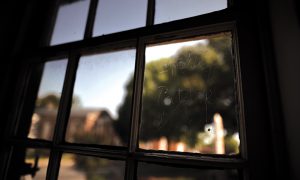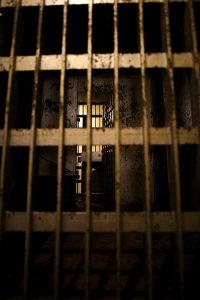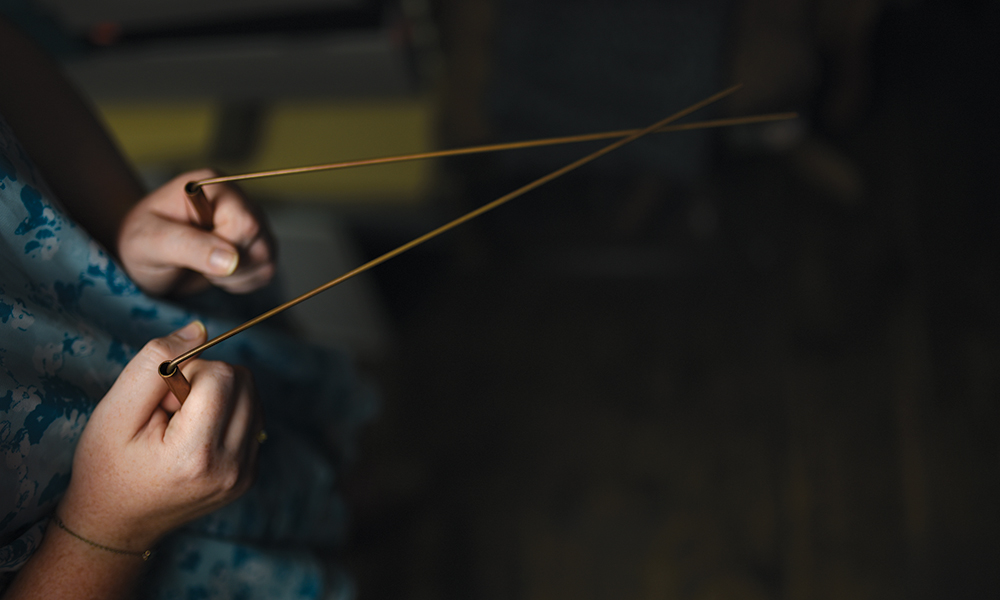Spirits give an added dimension to the Fauquier History Museum at the Old Jail
By Pam Kamphuis, Photos by Kara Thorpe
“Do you want to talk to Josie?” Erin Clark, executive director of the Fauquier History Museum at the Old Jail, asked me.
Did I want to talk to Josie? Of course I wanted to talk to Josie! Normally I wouldn’t get that excited about conversing with a pre-teen girl; after all, they’re a dime a dozen, but this one was different. Josie Pattie died in the Old Jail’s residence in the 1870s, at the age of 11. How do I know that? I asked her myself, and she answered.
As you may have guessed, the Fauquier History Museum at the Old Jail is thoroughly haunted. Josie is one of the better-known ghosts, but there are others, some whose identities are known, and some more obscure ones. Spirits have been detected by different mediums who come in as visitors to the museum, usually with corroborating results. Culpeper Paranormal Investigations (CPI) has also helped with the identification and documentation of some of the ghosts. They said that the Fauquier History Museum at the Old Jail is one of the two most haunted locations they’ve investigated, the other being the Kemper House in Madison. “We have captured evidence in almost every room at the Old Jail,” said Paul Warmack of CPI.
The staff at the museum communicate with some of its spirits using dowsing rods. The L-shaped brass rods, usually known for detecting underground water, are also said to be sensitive to the energies of spirits. Held by one person, one in each hand, yes or no questions are asked, and if the rods cross, the ghost is answering “yes,” and if they separate, the answer is “no.” That was challenging for me…so many things I wanted to ask Josie, so many questions popping into my head, but so hard to think how to phrase my ideas as yes or no questions. I wanted to ask, what did she die of? How many brothers and sisters did she have? Did she go to school? What sort of games did she play with her friends? What was Warrenton like during Reconstruction? How did she dress? What did her mother cook for dinner? When I visited the second time, with our photographer, Erin asked Josie if she’d ever had her photo taken. Unfortunately, the answer was no, otherwise I would have gone on a search for it…what wouldn’t I have given for a photo of Josie to go with this article?
CPI said, “I think the biggest thing for us is that it’s not just about going in and doing an investigation, it’s about learning about the stories of the place and the people of the past. It’s like reaching back and touching history, it’s like stepping back in time.
So, what’s it like working in the haunted building? Josie’s not the only ghost there, not by a long shot. Erin said, “We get asked about ghosts a lot. I always tell folks that if I were to tell them about all my experiences we would be here all day long.” As a museum director, Erin has worked in many historic buildings and homes, and admitted that the Old Jail is the most haunted place she’s experienced. “Our board of directors always jokes with me, asking if they told me the building was haunted during my interview, which they didn’t. In most jobs, on the first day of work, you meet the staff and get to know the building, where the coffeemaker is, that sort of thing. But here, you meet the ghosts. I met a ghost on the first day, using the dowsing rods. It took awhile for me to get used to being in the building by myself.” But, she said she’s never felt threatened or so scared she wanted to leave the building. CPI agreed that there don’t seem to be any evil or malevolent ghosts on the premises.
How do the ghosts make themselves known?
Usually, it’s sounds that alert the staff to the presence of spirits. Footsteps, sometimes the sounds of children running and playing (Josie and her siblings, perhaps?), a strong breeze through the hallway, previously closed and locked doors standing ajar when there’s no one else in the building and no wind to blow it open. Moving objects are rarer, but it does happen. An office door moving as if someone had bumped it passing by, a well-secured part of an exhibit removed from the wall and fallen in an unlikely place.
But there are visual signs too. “On our security cameras, there was a time from late May to early June, about nine or ten times during a two-week span, that we were catching a huge orb of light from one of the windows, floating around the room. It would be at different times, always at night, and it would move in different directions, up, down, right, left. You could see it turn, and see that it had dimension to it. One of the orbs had audio caught with it, too, on the security system. It sounded to me like a kind of a chime noise, but to some other people it sounds like a high pitched voice. My first reaction was to look for an explanation, like was someone outside with a flashlight, or was it a helicopter with a searchlight? I showed this video to board members and staff members, and we never found an explanation,” said Erin.
Josie’s story

Josie Pattie’s name is etched in the window in her bedroom upstairs in the 1823 addition. The etching appeared mysteriously in the 1970s.
Josie’s family had a strong connection to the jail; both her father, Horace Pattie, and one of her brothers were resident jailers, Horace in the 1860s through 1880s and then Caldwell in the 1900s through the 1930s. Horace’s family lived in the jailer’s residence, and Josie’s mother would have cared for her own family as well as cooking two meals a day for the prisoners out of the residence’s kitchen. We know, from census records, that Josie was between 10 and 14 when she died. We also know the Patties lost several young children during the time they lived here, likely to illness or epidemic.
Upstairs in the residence building, to the right of the stairs, there are two rooms. One would have been the children’s bedroom, presumably where Josie died, and the other likely the parents’ bedroom. These two rooms are where Josie hangs out. Erin’s office is in one of those rooms today. So how does she know when Josie’s there? Erin explained, “A lot of former directors of the jail have experienced her. She likes to tug hair gently. She also likes to tickle people’s elbows. Some directors have heard her laughing and playing. When I got my new desk, she would play with the shiny brass drawer pulls, flipping them up and down so they would ding. She did that for about a month after I got the desk, then it kind of quieted down. Maybe she was attracted to it because it was a new object. If I was a little girl in the 1870s I’d like a shiny brass knob, too. Once, when I was in the next room over, I was telling one of our board members the story, and shortly after I finished we could hear her playing with them. She knew that we were there, and she was just playing around.” More corroborating evidence: CPI said, “We’ve gotten recordings in there that sound like a little child’s voice, and we’re assuming that’s Josie.”
The Civil War Soldier
A couple of other potentially identifiable spirits also inhabit the buildings. Josie has a companion ghost in the upstairs room, a Civil War soldier who has also communicated through the dowsing rods. Erin said, “His answers are always consistent. We have asked him many times through different people if he was Union or Confederate, whether he was infantry, cavalry, or artillery, and if he is buried in Warrenton. Every time he has answered that he was Confederate infantry, and he is indeed buried in Warrenton. Whenever we ask if he’s there protecting Josie, or if Josie’s there, he always says yes, and Josie says the same thing.” He has been potentially identified as Captain John Scott, via his very clear communications through the dowsing rods involving a laborious process of alphabetical yes or no questions. His name is on the Confederate Memorial here in Warrenton. He died in the early 1900s, and it is not clear why he would be inhabiting the Old Jail.
Mr. McGhee
 Another ghost that mediums often sense is Mr. McGhee. He lived in northern Fauquier County in the 1920s and he was most likely suffering from what we now know as dementia. Erin related, “He was afraid that someone was going to take his house, so he burned it to the ground and tried to take himself with it. He was arrested and brought to the jail here, and was charged with attempted suicide and arson. Since he was elderly, he was put in one of our maximum security cells so he could be watched. He came down with pneumonia, and while the staff was in the process of finding him a bed in an infirmary, he passed away here at the jail. He’s said to still be up there—there are accounts of other prisoners seeing the spirit of an elderly man with a beard who comes in the middle of the night and tries to take their blankets. And all the accounts were consistent, an exact description of Mr. McGhee. We have some photos of the cell back there where you can see a dark human-shaped shadow. We’re not sure if that’s Mr. McGhee but it’s in the right area where he would be, so it might be him.”
Another ghost that mediums often sense is Mr. McGhee. He lived in northern Fauquier County in the 1920s and he was most likely suffering from what we now know as dementia. Erin related, “He was afraid that someone was going to take his house, so he burned it to the ground and tried to take himself with it. He was arrested and brought to the jail here, and was charged with attempted suicide and arson. Since he was elderly, he was put in one of our maximum security cells so he could be watched. He came down with pneumonia, and while the staff was in the process of finding him a bed in an infirmary, he passed away here at the jail. He’s said to still be up there—there are accounts of other prisoners seeing the spirit of an elderly man with a beard who comes in the middle of the night and tries to take their blankets. And all the accounts were consistent, an exact description of Mr. McGhee. We have some photos of the cell back there where you can see a dark human-shaped shadow. We’re not sure if that’s Mr. McGhee but it’s in the right area where he would be, so it might be him.”
The Lady in White
A few decades ago, the museum’s board of directors was having a meeting in the war room, and the shape of a lady dressed in white walked out of the fireplace. Five out of the six board members saw her. She walked back into the fireplace, and they picked up and moved their meeting elsewhere. “We’re not sure of her identity,” said Erin. “Supposedly she was one of the jailers’ wives. There’s a story here that one of the wives suffered severe burns from a fire and passed away a few days later, so that could be an explanation.”
Erin said, “I always talk to the ghosts, I say hello and goodbye to them. And I acknowledge their existence. Whenever I hear something strange, I say out loud, ‘Yes, I hear you,’ and go about my day. I do feel that they listen. I think sometimes that’s what they want, to be remembered and noticed. When we had the orb back in May and June, one night when I was leaving I said good night, and I said, ‘I want to let whoever’s floating around in here know that we see you, and have a good night.’ And the orb hasn’t come back since. That was the last time we saw it. So that to me kind of sealed it. I don’t know if maybe it got scared, or maybe that’s all it needed, to know that we see it.”
History of the Fauquier History Museum at the Old Jail
 The front stone building of the Old Jail, where the entrance to the museum and the gift shop are now, was built first, in 1808. It was the sixth jail built in the county, and it replaced older, wooden structures. Conditions there were deplorable, with four cells, no heat, no floor, and no full time jailer. There was one full time sheriff in the county, who cared for the prisoners as well as fulfilling the rest of his duties. So there were no regular meals, and no one to let the prisoners out to go to the bathroom, either. As a result, there was a lot of disease. In 1820, the state of Virginia sued Fauquier County due to the bad jail conditions. The newer stone jail was built in 1823, the original building was turned into the jailer’s residence, and the kitchen was added at that time. So that way there was a full time jailer who lived there with his family, and his wife had the job of cooking for the prisoners. The jail remained in service until 1966.
The front stone building of the Old Jail, where the entrance to the museum and the gift shop are now, was built first, in 1808. It was the sixth jail built in the county, and it replaced older, wooden structures. Conditions there were deplorable, with four cells, no heat, no floor, and no full time jailer. There was one full time sheriff in the county, who cared for the prisoners as well as fulfilling the rest of his duties. So there were no regular meals, and no one to let the prisoners out to go to the bathroom, either. As a result, there was a lot of disease. In 1820, the state of Virginia sued Fauquier County due to the bad jail conditions. The newer stone jail was built in 1823, the original building was turned into the jailer’s residence, and the kitchen was added at that time. So that way there was a full time jailer who lived there with his family, and his wife had the job of cooking for the prisoners. The jail remained in service until 1966.
October 19, 20, 26, 27- Ghost Tours running at the Fauquier HIstory Museum at the Old Jail, Schedule at www.fauquierhistory.org

Leave a Reply